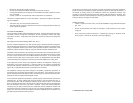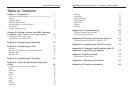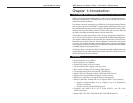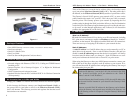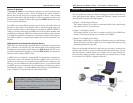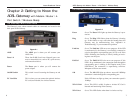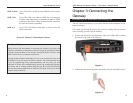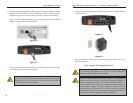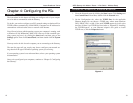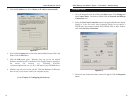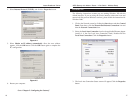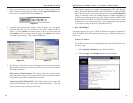
ADSL Gateway with Modem / Router / 4-Port Switch / Wireless-Ready
3
Think of the Gateway as a network device with two sides: the first side is made
up of your private Local Area Network (LAN) of PCs. The other, public side is
the Internet, or the Wide Area Network (WAN), outside of your home or office.
The Gateway’s firewall (NAT) protects your network of PCs so users on the
public, Internet side cannot “see” your PCs. This is how your LAN, or network,
remains private. The Gateway protects your network by inspecting the first
packet coming in through the WAN port before delivery to the final destination
on the LAN port. The Gateway inspects Internet port services like the web serv-
er, ftp server, or other Internet applications, and, if allowed, it will forward the
packet to the appropriate PC on the LAN side.
What’s an IP Address?
IP stands for Internet Protocol. Every device on an IP-based network, including
PCs, print servers, and routers, requires an IP address to identify its “location,”
or address, on the network. This applies to both the WAN and LAN connections.
There are two ways of assigning an IP address to your network devices.
Static IP Addresses
A static IP address is a fixed IP address that you assign manually to a PC or
other device on the network. Since a static IP address remains valid until you
disable it, static IP addressing ensures that the device assigned it will always
have that same IP address until you change it. Static IP addresses are com-
monly used with network devices such as server PCs or print servers.
When using the Gateway to share your ADSL Internet connection, contact your
ISP to find out if they have assigned a static IP address to your account. If so,
you will need that static IP address when configuring the Gateway. You can get
the information from your ISP.
IP Addresses
Note: Since the Gateway is a device that connects two networks, it
needs two IP addresses—one for the LAN side, and one for the WAN
side. In this User Guide, you’ll see references to the “WAN IP
address” and the “LAN IP address.”
Since the Gateway has firewall security (NAT), the only IP address that
can be seen from the Internet for your network is the Gateway’s WAN
IP address.
However, even this WAN IP address for the Gateway can be blocked,
so that the Gateway and network seem invisible to the Internet—see
the IP Filtering section in “Chapter 6: Using the Gateway’s Web-based
Utility.”
Instant Broadband
™
Series
2
• One ADSL Gateway with Modem / Router / 4-Port Switch / Wireless-Ready
• One Power Adapter
• One RJ-11 Phone Cable
• One User Guide
• One Fast Start and Registration Card (not shown)
• Network Adapter with Ethernet (UTP CAT 5) Cabling and TCP/IP Protocol
Installed per PC
• Internet Explorer 4.0 or Netscape Navigator 4.7 or Higher for Web-based
Configuration
• ADSL Connection and Activated Account
• Optional Wireless Network PC Card Model WPC11 for Wireless Connection
(sold separately)
Simply put, a router is a network device that connects two networks together.
In this instance, the Gateway connects your Local Area Network (LAN), or
the group of PCs in your home or office, to the Wide Area Network (WAN),
that is, the Internet. The Gateway processes and regulates the data that travels
between these two networks.
Minimum Requirements
Package Contents
Figure 1-1
An Introduction to LANs and WANs





